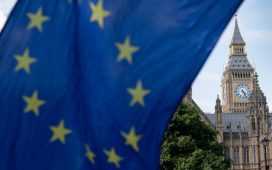Euro on track for best week in 16 years
After a seismic week for the future of Europe, the euro is on track for its best week since the financial crisis 16 years ago.
The euro has climbed by 4.6% so far this week against the US dollar, from $1.0375 a week ago to $1.086 today.
That would be its biggest gain, in percentage terms, since the week to 20 March 2009, when the financial markets were being rattled by the recession following the global financial crisis.
In value terms, it’s on track to be the sixth best week in at least the last 20 years.
This week has seen the sixth biggest weekly upmove in EURUSD since the Euro’s inception in 1999!
– The top four were all during the financial crisis – with the biggest upmove on record being the +692 points rise on the week ending 20th March 2009
– Outside the Financial crisis –…— Philippe Loustaunau (@philoust) March 7, 2025
This week, the euro has benefitted from the slide in the value of the US dollar as Donald Trumps’s threatened trade wars hurt the US currency.
But the euro has also gained against sterling, up to 83.95p, from 82.46p a week ago.
“The euro continues to benefit from the apparent change in the eurozone’s fiscal stance,” says Achilleas Georgolopoulos, senior market analyst at Trading Point.
There was a fiscal sea change in Germany this week, where major parties are pushing plans to reform the country’s debt brake, to allow for higher defense spending.
Last night, European leaders agreed to a massive increase to defence spending, to bolster Europe’s defence industry and increase its military capability.
Key events
Ahead of the US jobs report in 10 minutes, Derren Nathan, senior equity analyst at Hargreaves Lansdown, says:
“It’s not just Elon Musk’s public sector efficiency drive that’s impacting (the job market). Cuts are also being felt in retail and technology.
“While weaker (jobs) data may support the case for further Fed rate cuts, job creation remains a key engine of economic growth.”
Investors brace for US jobs report
Tensions is building in the financial markets as investors await the latest US jobs report.
February’s non-farm payroll (NFP) – covering the first full month of Donald Trump’s second presidency – is expected to show a rise in employment. The data is due at 1.30pm UK time, or 8.30am on the east coast.
Wall Street economists predict the NFP rose by 160,000 in February, up from a 143,000 increase in January.
But, there are fears that Elon Musk’s push to reduce the size of the government and to cut government spending through his Doge initiative could be weakening the labour market.
Earlier this week, a survey of private sector payroll growth was much weaker than expected – with hiring slowing to just 77,000 new jobs last month.
The strength of the US jobs market is a crucial factor determining how quickly the Federal Reserve cuts interest rates this year.
We’ll also get an updated unemployment rate reading, and estimates of how much wages rose last month.
Stephen Innes, managing partner at SPI Asset Management, says:
The consensus for today’s NFP print sits at +160K jobs, with unemployment steady at 4%, and wage growth holding at 4% YoY.
A negative surprise could send the dollar tumbling, especially after this week’s policy-driven repricing across markets.
World food prices rose in February
The rising cost of sugar, dairy and vegetable oil pushed up global food commodity prices in February, the UN’s Food and Agriculture Organization (FAO) reported today.
The FAO Food Price Index, which tracks a basket of food commodities, rose by 1.6% in February. While the meat price index remained stable, all other price indices rose, with the most significant increases recorded for sugar, dairy and vegetable oils, the FAO says.
Sugar prices jumped by 6.6% in the month, due to concerns over tighter global supplies in the 2024/25 season.
The FAO explains:
Declining production prospects in India and concerns over the impact of recent dry weather on the upcoming crop in Brazil, which exacerbated the seasonal effect, underpinned the increase in prices. Additionally, the strengthening of the Brazilian real against the United States dollar, which tends to affect exports from Brazil, further contributed to the overall increase in global sugar prices.
The Vegetable Oil Price Index rose 2%, driven by higher prices for palm, rapeseed, soy and sunflower oils.
The report says:
After a brief decline in January, international palm oil prices rebounded moderately and maintained their premiums over competing oils. The increase was largely underpinned by seasonally lower outputs in Southeast Asian producing countries and expectations of increased demand from the biodiesel industry in Indonesia.
Dairy prices rose by 4%, driven by higher prices across all major dairy products.
According to the FAO:
International cheese prices increased for the third consecutive month, rising by 4.7 percent from January. The rise was fueled by strong import demand, as recovering production in Europe was offset by seasonal output declines in Oceania.
Trump says tariffs could go up over time -Fox Business interview
U.S. President Donald Trump said U.S. tariffs could go up over time but gave no other details, according to an excerpt of a Fox Business interview taped on Thursday that aired on Friday, Reuters reports.
Asked whether businesses could get clarity about his tariff plan, Trump said:
“Well, I think so. But, you know, the terms could go up as time goes by, and they may go up and, you know, I don’t know if it’s predictability.”
(One can assuse Trump of many things, but predictability would not be at the top of the list)
The US dollar is “losing its crown”, reports Kathleen Brooks, research director at XTB:
US stocks might be dragging other markets with it, but the decline in the dollar has allowed the euro to roar back to life. EUR/USD is higher by 3.3% this week and is the second best performing currency in the G10. $1.10 is looking like the next major level for this pair. The currency has been boosted by Germany’s planned fiscal bazooka to reboot its flagging economy.
Although the European bond market has stabilized at the end of the week, Eurozone sovereign yields have still surged 32 bps so far this week. The bond market does not seem to care about the details of Germany’s spending plans, the timeline or the fact it has been announced by Friedrich Merz, even though he has not yet managed to form a government. This could lead to a short-term recovery in bond yields, although the euro is continuing to rise, suggesting that the euro’s rise has untethered from Europe’s bond market.
Good news! The eurozone grew faster than previously thought at the end of last year.
Eurozone GDP rose by 0.2% in October-December, new data from statistics body Eurostat shows, up from a previous estimate of 0.1% growth.
The change follows a big upgrade to Ireland’s GDP in Q4 2024 – it grew by 3.6%, due to growth among its multinationals.
However, France (-0.1%) and Germany (-0.2%) are both on the brink of recession after contracting in October-December.
European stock markets are on track for a weekly loss.
The pan-European Stoxx 600 index has dropped by around 1% this week.
Today, Germany’s DAX has dropped by 1.5% after the early-morning drop in factory orders (see earlier post), but is still up over 2% this week, cheered by the ‘big bazooka’ fiscal loosening plan.
The euro has now nudged a new four-month high of $1.086 against the US dollar.
BofA Global Research has raised its forecast for the euro to reach $1.15 by the end of 2025.
In a note published today, BofA argue that German’s new fiscal package is “a watershed moment” for the currency, Reuters reports.
Euro on track for best week in 16 years
After a seismic week for the future of Europe, the euro is on track for its best week since the financial crisis 16 years ago.
The euro has climbed by 4.6% so far this week against the US dollar, from $1.0375 a week ago to $1.086 today.
That would be its biggest gain, in percentage terms, since the week to 20 March 2009, when the financial markets were being rattled by the recession following the global financial crisis.
In value terms, it’s on track to be the sixth best week in at least the last 20 years.
This week has seen the sixth biggest weekly upmove in EURUSD since the Euro’s inception in 1999!
– The top four were all during the financial crisis – with the biggest upmove on record being the +692 points rise on the week ending 20th March 2009
– Outside the Financial crisis –…— Philippe Loustaunau (@philoust) March 7, 2025
This week, the euro has benefitted from the slide in the value of the US dollar as Donald Trumps’s threatened trade wars hurt the US currency.
But the euro has also gained against sterling, up to 83.95p, from 82.46p a week ago.
“The euro continues to benefit from the apparent change in the eurozone’s fiscal stance,” says Achilleas Georgolopoulos, senior market analyst at Trading Point.
There was a fiscal sea change in Germany this week, where major parties are pushing plans to reform the country’s debt brake, to allow for higher defense spending.
Last night, European leaders agreed to a massive increase to defence spending, to bolster Europe’s defence industry and increase its military capability.
All Eurostar Paris trains cancelled on Friday amid French rail disruption over suspected WW2 bomb – Europe live
There’s significant disruption to Eurostar services today, after an suspected unexploded bomb from the second world war was found on railway tracks in the commune of Saint Denis.
Eurostar has just confirmed to the Guardian that “all Eurostar trains are cancelled to and from Paris today.”
That includes all services on lines: London-Paris, Paris-London, Brussels-Paris and Paris-Brussels.
Our Europe live blog has all the action:








